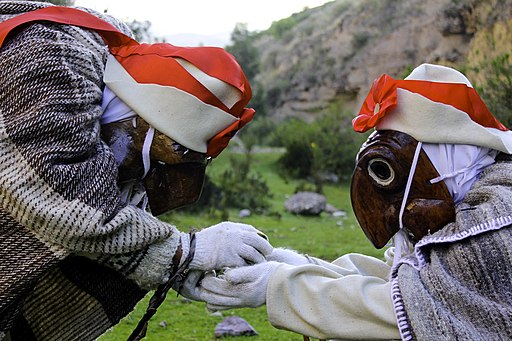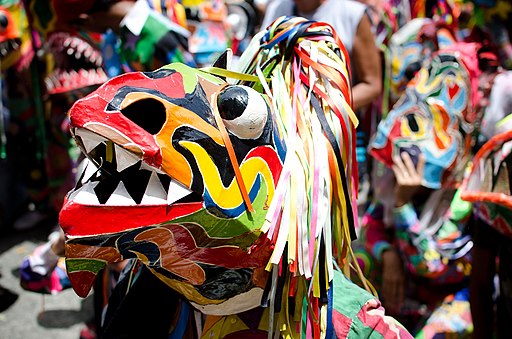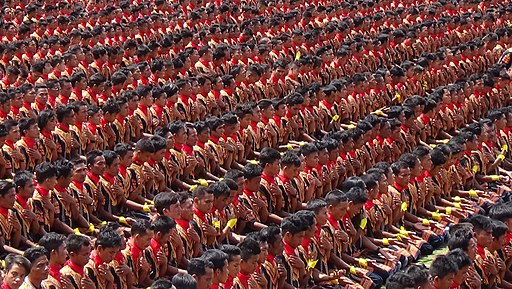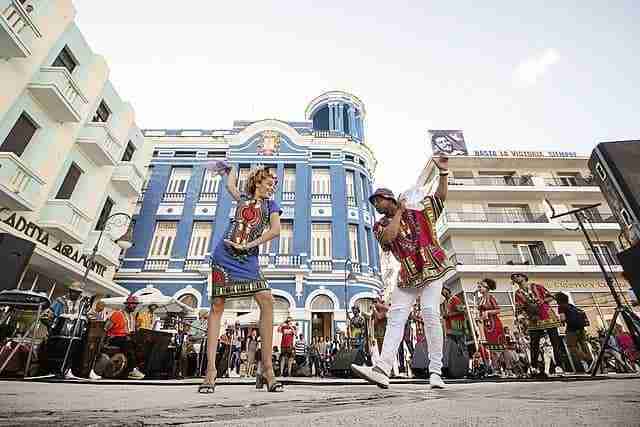The Intangible Cultural Heritage of Humanity
The Cultural Heritage of a territory is understood more and more in a broad sense. And includes both tangible and intangible cultural resources. Since also the intangible assets of the communities refer to expressions of identity. And also legacy of the past transmitted to future generations.
Rumba in Cuba
 Manuel Díaz Reyes, CC BY-SA 4.0, via Wikimedia Commons
Manuel Díaz Reyes, CC BY-SA 4.0, via Wikimedia Commons
UNESCO has taken into account this evolution and extension of the concept of Cultural Heritage. And, after an initial subdivision of the World Heritage into Cultural Heritage and Natural Heritage. Further distinguishes the Cultural Heritage into Tangible and Intangible Heritage.
Huaconada, ritual dance of Mito, Peru
 Photo by Carlos Daniel Gomero Correa, CC BY 2.0, via Wikimedia Commons
Photo by Carlos Daniel Gomero Correa, CC BY 2.0, via Wikimedia Commons
This new subdivision highlights even more the growing interest in the intangible aspects of culture. As main factors of cultural diversity. And the profound interdependence among intangible cultural heritage, material cultural heritage and natural assets.
Furthermore, the UNESCO Convention for the Protection of Intangible Cultural Heritage was born with the need to create an instrument of both protection. And awareness of the importance of these identity resources.
Dancing Devils of Corpus Christi, Venezuela
 Photo by Raúl Briceño, CC BY-SA 3.0, via Wikimedia Commons
Photo by Raúl Briceño, CC BY-SA 3.0, via Wikimedia Commons
The UNESCO Convention for the Protection of Intangible Cultural Heritage defines intangible cultural heritage as the practices, representations, expressions. As well as knowledge and skills (including tools, objects, artefacts, cultural spaces). Which communities, groups and, in some cases, individuals recognize it as part of their cultural heritage. Sometimes called “living cultural heritage” and manifests itself in:
- traditions and oral expressions. For example: traditional songs, legends and fairy tales;
- the performing arts. For example: traditional music, theatre, dance, masked ball, puppet show;
- social customs, ritual and festive events. For example: seasonal festivals, parades and processions, carnival customs or games;
- knowledge and practices relating to nature and the universe. For example: traditional medical or agricultural knowledge;
- traditional craftsmanship. For example: traditional processing, creation or painting of stone, soil, wood, metal, leather, paper, glass and textiles.
The Cultural Heritage therefore includes the tangible and intangible heritage expression of the communities residing in the territory. Traditions, in fact, continue to mark the life of the populations who inhabit a territory. As they represent their origins. And also are the expression of the environment in which they lived and continue to live.
The performing arts. And especially traditional popular festivals. Arise from the ability and will of man to socialize with particular rituals and at certain times of the year. In particular, the first festivals are linked to the alternation of the seasons and the collection of natural products; with the spread of Christianity, most of these festivals began to be linked to religion. While often retaining the elements of previous traditions and a close relationship with popular rites.
Armenian letter art and its cultural expressions, Armenia
 Armineaghayan, CC BY-SA 4.0, via Wikimedia Commons
Armineaghayan, CC BY-SA 4.0, via Wikimedia Commons
Traditional crafts are also strongly linked to the territory. As well as to the history of the communities. Each people, in fact, tends to enhance and make the resources available to them distinctive.
Intangible Cultural Heritage requirements
To be registered in the list of protected assets, an intangible cultural asset must also possess the following characteristics:
- transmitted from generation to generation;
- constantly recreated by communities and groups in close correlation with the surrounding environment and its history;
- to allow communities, groups and individuals to develop a sense of social and cultural belonging;
- promote respect for cultural diversity and human creativity;
- disseminate compliance with respect for human rights and the sustainability of the development of each Country.
The oral and intangible heritages of humanity are expressions of the intangible culture of the world. That UNESCO has included in a special list. To underline the importance they have according to this organization. Intangible cultural assets are side by side with world heritage sites. While the latter represent tangible things (such as a natural park, a city or an archaeological complex). The former represent ancient traditions that often do not have a “written” codification. But are handed down orally over the generations. So, UNESCO has set itself the problem of safeguarding these traditions to avoid their disappearance. In the same way as it has already done for material goods.
Khon, masked dance drama, Thailand
 Photo by setthayos sansuwansri por Pixabay
Photo by setthayos sansuwansri por Pixabay
The 32nd General Conference of UNESCO. Held in Paris in 2003. Established a Convention for the Safeguarding of Intangible Cultural Heritage. Furthermore created several lists:
– “Representative list of the intangible cultural heritage of humanity”;
– “List of the intangible cultural heritage that needs to be urgently safeguarded” for assets at risk of extinction;
– List of “Programs, projects and activities for the protection of intangible cultural heritage “. I.e. local initiatives that best reflect the principles of the Convention. And which will receive international assistance.
Since 2008, the lists have been adapted to the Convention and new elements have been added regularly every year. To date, UNESCO has recognized 584 items in 131 Countries around the world as Intangible Heritage.
Saman dance, Indonesia
 Photo by Iwan IUI, CC BY-SA 4.0, via Wikimedia Commons
Photo by Iwan IUI, CC BY-SA 4.0, via Wikimedia Commons
Resume
Cultural heritage in general consists of the products and processes of a culture that are preserved. And also passed down through the generations. Part of this heritage takes the form of tangible artefacts such as buildings or works of art. Many parts of the culture, however, are intangible, including singing, music, dance, theatre, skill, cooking, crafts, and festivals. These forms of culture can be recorded but cannot be touched. Or stored in physical form (like for example in a museum).
The world cultural heritage is not only made up of a set of places, objects and monuments, but also includes all those intangible expressions in which the history and traditions of a people are manifested. It is therefore essential to safeguard these testimonies of cultural diversity. To pass them on to new generations. And to encourage intercultural dialogue. UNESCO has among its priority objectives precisely the implementation of measures to promote the transmission of cultural heritage. Both tangible and intangible. Among generations.
